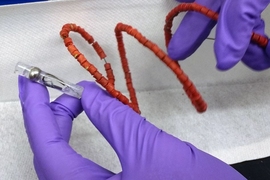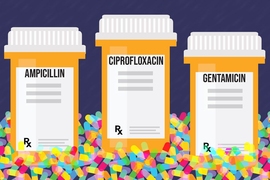For tuberculosis patients, complying with a full course of treatment can be daunting and difficult. But a new experiment conducted by MIT researchers in Kenya, in collaboration with the digital health company Keheala, shows that a digital program used on mobile phones helps patients successfully finish their treatments.
The program created interactive communication between patients and providers — rather than, say, one-way reminders about medication — and also used behavioral-science insights to help motivate patients to continue their recovery regimens.
After the experimental intervention, only 4 percent of tuberculosis patients had unsuccessful treatment outcomes. For comparison, 13 percent of patients in a control group, who did not use the platform, didn’t finish their treatment.
“Patients who we supported with our mobile platform were two-thirds less likely to fail to complete treatment,” says Erez Yoeli, a research scientist at the MIT Sloan School of Management and co-author of a newly published paper outlining the experiment’s results.
The paper, “Mobile Self-verification and Support for Successful Tuberculosis Treatment,” appears today in the New England Journal of Medicine.
The co-authors are Yoeli; David Rand, an associate professor in the MIT Sloan School of Management; Jon Rathauser, CEO of Keheala, a digital health care firm based in Tel Aviv; Syon P. Bhanot, an assistant professor of economics at Swarthmore College; Maureen K. Kimenye and Eunice Mailu of the Kenya Ministry of Health; Enos Masini of the World Health Organization; and Philip Owiti of the International Union Against Tuberculosis and Lung Disease.
Tuberculosis treatments often take six months, and a substantial number of patients break off treatment when they are feeling better but have not fully recovered. If individuals stop taking medicine and relapse, it can also have harmful effects for larger communities as well, since tuberculosis is contagious.
So why do people break off their treatments?
“Stigma, access to care challenges, burdensome treatment protocols, and a lack of information, motivation, and support make it difficult for patients to do the right thing and take their medication,” says Rathauser, who founded Keheala in 2014 to try to create tools to try to overcome logistical hurdles to health care delivery in the developing world.
To conduct the study, the researchers teamed up with 17 health care clinics in Nairobi, the capital of Kenya, to create a randomized trial. There were 569 patients who participated in the intervention, and 535 patients in the control group who did not use the mobile digital program. The study was approved by the institutional review boards of Kenyatta National Hospital and the University of Nairobi.
The researchers, working with Keheala, developed a health platform for the tuberculosis patients that works on “feature phones,” which are generally limited to talk and texting functionality, and are relatively common in Kenya in areas more prone to contagious disease outbreaks.
Among other things, the program sent daily messages to patients asking them to verify that they were sticking to their medical routines. If patients did not respond to the daily messages, they would get follow-up messages and then ultimately phone calls from members of the research team who themselves had experience with TB treatment. The clinic treating the patient would be notified as well.
In this way, Yoeli explains, the program used two key behavioral principles to improve patient actions: both “increased observability” of treatment adherence and “eliminating plausible deniability,” that is, reducing their ability to make excuses for not taking their medication.
The program also provided information about tuberculosis, motivational messages, an “adherence contest,” and emphasized the community benefits of continuing treatment. “Throughout, we tried to give the individual as much credit as possible for their good deed toward the community,” adds Yoeli.
The success of the experiment, Rand says, reinforces how crucial the behavior and psychology of patients can be in these situations.
“Nonadherence with treatment regimes is a major problem in medicine that leads to serious negative health outcomes,” Rand says. “But critically, the challenge is not medical — it’s behavioral.”
As a result, Rand adds, “this is a space where behavioral science can play a major role in improving health outcomes. To me, what is so exciting about this paper is that we show how an intervention which is technologically quite simple has a really large positive impact because it is designed in a psychologically sophisticated way.”
Researchers with global expertise in the field say the findings are valuable. Jessica Haberer, an associate professor of medicine at Harvard Medical School and the director of global health research at Massachusetts General Hospital, who has read the paper, observes that “the study was well done,” adding, “The primary outcome shows great promise for the intervention.” As she notes, tuberculosis causes more deaths worldwide than any other infectious disease — an estimated 1.7 million in 2017 — and methods like the one in this experiment could reduce the incomplete treatment courses that are one source of the problem.
Haberer also notes that although the long-term tracking of tuberculosis patients is costly and difficult, in the future, the “impact of the intervention could be better assessed through long-term follow-up,” in order to find out how many patients have reached, for instance, 18 months of disease-free survival. Such longitudinal data, she notes, has been historically “underutilized” in the area of tuberculosis research.
Indeed, as the researchers acknowledge, any one study can have limitations. In this case, they would also like to see how the method fares in rural settings, which may present even greater health care access challenges.
“One key thing the next study needs to show is that this approach works not just in the city of Nairobi, but for a more diverse population, including rural patients,” Yoeli states.
In fact, the researchers are now in the midst of a three-year randomized controlled trial which expands the geographic scope of the experiment, and also evaluates its cost-effectiveness more thoroughly. The team says it would also like to apply the concept to HIV treatment programs in the future as well.
The researchers, and Keheala, received support from Development Innovation Ventures (DIV), a fund of the United States Agency for International Development (USAID) that tests solutions to global development challenges through a year-round grant competition.










